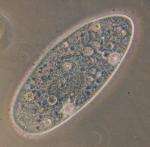Betsy and John focused on their own sciences while doing their Ph.D. research at Oak Ridge National Laboratory. They lived in Oak Ridge, in the third floor of an apartment block affectionately known as “The Bricks.” Rent was $62.50 a month.
Betsy collaborated with Richard B. Setlow, a physicist who was one of the pioneers in the study of DNA damage by UV radiation and repair. Setlow and others had shown that bacteria can naturally repair the DNA damage caused by UV light. For her dissertation, Betsy showed that protozoa can do the same. Her 1968 Science paper was the first demonstration of photoreactivation in a eukaryote.
While Betsy was coaxing organisms called paramecia to demonstrate photoreactivation in eukaryotes, John was immersed in vacuum ultraviolet spectroscopy and radiation physics, understanding how radiation interacts with matter. One of his research achievements was showing that sodium is very close to being a free-electron metal. This finding contradicted earlier results, which were later shown to be an artifact.
Betsy and John focused on their own sciences while doing their Ph.D. research at Oak Ridge National Laboratory. They lived in Oak Ridge, in the third floor of an apartment block affectionately known as “The Bricks.” Rent was $62.50 a month.
Betsy collaborated with Richard B. Setlow, a physicist who was one of the pioneers in the study of DNA damage by UV radiation and repair. Setlow and others had shown that bacteria can naturally repair the DNA damage caused by UV light. For her dissertation, Betsy showed that protozoa can do the same. Her 1968 Science paper was the first demonstration of photoreactivation in a eukaryote.
While Betsy was coaxing organisms called paramecia to demonstrate photoreactivation in eukaryotes, John was immersed in vacuum ultraviolet spectroscopy and radiation physics, understanding how radiation interacts with matter. One of his research achievements was showing that sodium is very close to being a free-electron metal. This finding contradicted earlier results, which were later shown to be artifacts.
PUBLICATIONS

